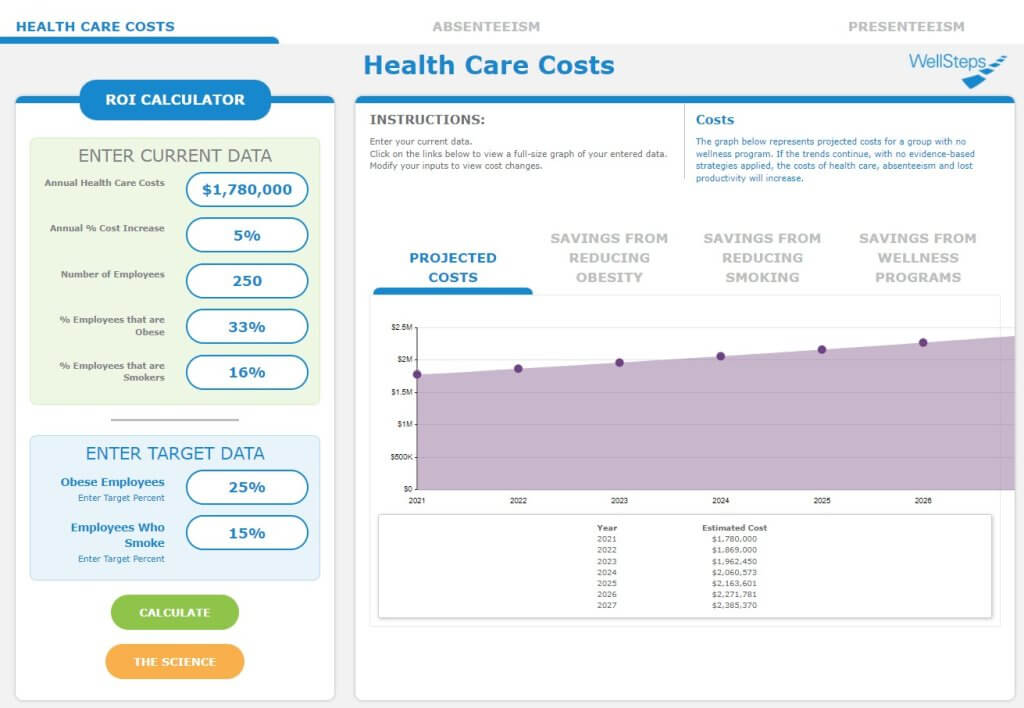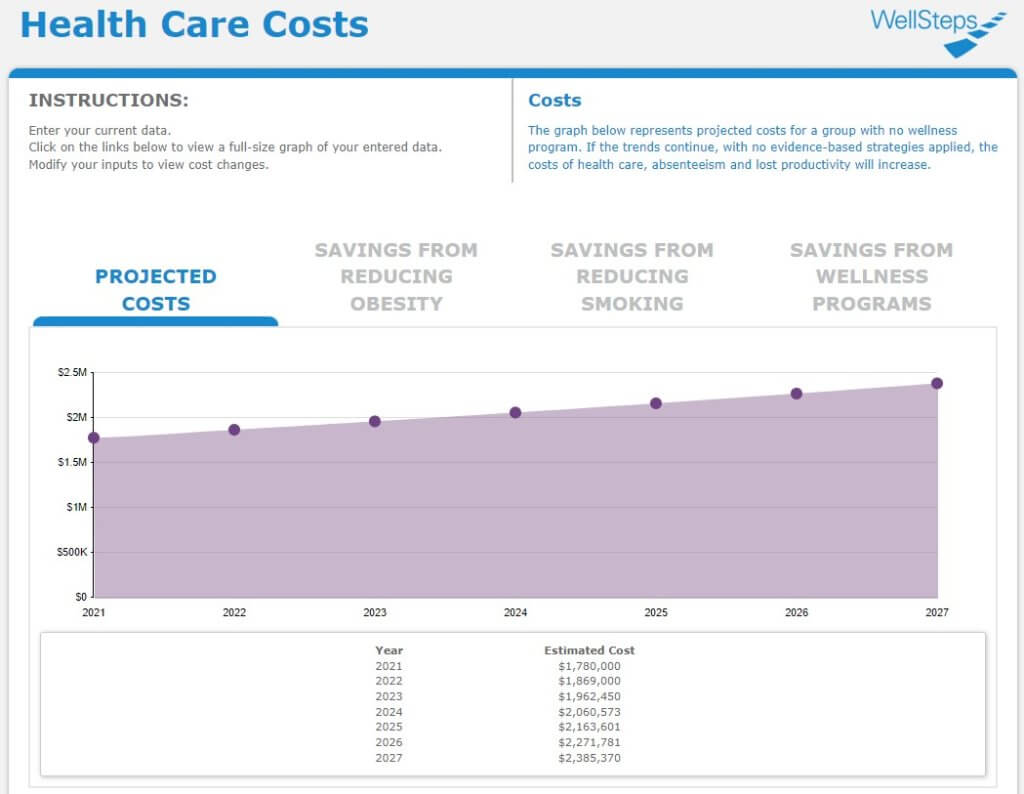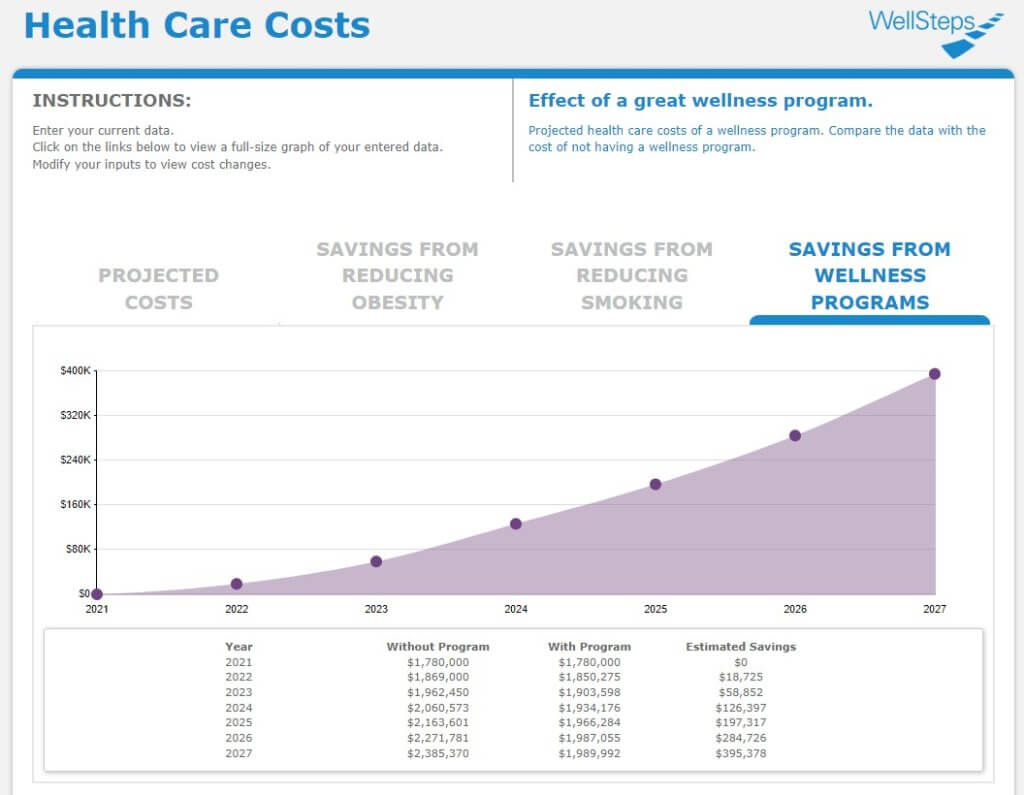Have you ever watched a young child pick up a full glass of punch and start walking? Undoubtedly, the outcome is inevitable… there will be punch on the carpet. How can you know what the outcome will be? Comparatively, how can you know how much money a wellness program will save?
After all, this may be the first time you’ve ever watched this child handle punch and, yet, somehow you know what is going to happen. The outcome is predictable because we’ve all seen the same thing happen in the past.
Based on what we have seen and experienced in the past, we can be fairly confident about what will happen in the near future. Our best predictors of the future come from the past.
Our best predictors of the future come from the past.
It’s true for kids and punch, it’s also true for investing in the stock market. And, it’s true for predicting how much money a wellness program will save in employee healthcare costs. In fact, the best predictor of future healthcare costs is past healthcare costs. Insurance companies call this, in essence, credibility.
Do Wellness Programs Save Money With Rising Costs of Healthcare?
Credibility is an actuarial term describing the degree of accuracy in forecasting future events based on statistical reporting of past events. Credibility is not the only predictor, but it is the best predictor.
Age, gender, socioeconomic status, race, lifestyle and even location can also predict healthcare costs. The presence of a wellness program can also influence company medical costs.
Each year healthcare costs increase and each year employers struggle to handle the added financial burden. Healthcare cost increases are worse than the cost increases associated with labor, materials, or energy.
According to a recent business roundtable survey, in fact, CEO’s rank the cost of health care as one of the biggest threats to company profits.1
RELATED: Proof Wellness Programs in the Workplace Save Money
Burden of Reducing Healthcare Costs
Certainly, yearly increases in employee medical care costs are on the radar screen of every successful workplace. One of the more commonly used solutions, generally, has been cost shifting − passing the increases along to employees or customers.

From a company perspective these tactics do reduce the healthcare cost burden for the company, but they do not address the core of the problem: the high demand and high cost of health care.
When we look at the exact reasons why healthcare costs increase, it’s clear that wellness programs can only impact a few of these cost drivers. Worksite wellness programs are, in short, effective at reducing the demand for health care which lowers cost and helps employers save money.
Wellness programs make sense and they have been shown to work, yet they are rarely included in any discussions about future healthcare costs.
Wellness programs make sense and they have been shown to work, yet they are rarely included in any discussions about future healthcare costs. However, this oversight can usually be explained by one reason: a lack of appreciation for the strength of the business case for wellness. The fact is, the return on a wellness program investment is nearly always positive.
And even when an investment of $1 yields a meager return of just $1, that means that the benefit is essentially free! Who wouldn’t provide such a benefit? In fact, this is exactly what a large review of the wellness science, known as the RAND report, demonstrates (see page xxvi).
RELATED: Employee Wellness Programs: How They Save Money
The RAND Report Shows Wellness Programs Save Money
It is amazing how original research pieces like the RAND report can get twisted and changed by the blogosphere and the media. Here is the executive summary of the RAND report. In just a few paragraphs, the authors clearly shows that the science is very supportive of wellness programs.
But, the critics cry foul. However, they ignore the 98% of the report that says programs work and they focus on the 2% of results that are not spectacular.
Indeed, this perspective is truly perplexing. Of course, there are wellness vendors out there making unsubstantiated claims and promoting programs that do nothing, just like any other business.

However, well organized, comprehensive programs such as this one are very effective. Besides ignoring all of the science behind wellness programs, most critics are long on complaints and short on solutions.
It’s one thing to complain about something, and quite another to actually do something about it. We consequently welcome all criticism if it is accompanied by new ideas, solutions, or new approaches.
RELATED: 3 Years of Worksite Wellness – A Zero Trend Case Study
Wellness ROI Calculators Forecast How Much Wellness Programs Save
Whether you are unconvinced of the value of wellness programs or you are considering an investment in employee wellness, wouldn’t it be useful to see how these programs can realistically affect a company’s bottom line? If you already have a wellness program, wouldn’t it be helpful to know what you can expect to save in future medical costs?
No matter where you are in your thinking with respect to an employee wellness program, it could certainly be beneficial to have a straightforward and accurate way to forecast how an employee wellness program can impact employee-related cost trends at your worksite.
There are some forecasting tools on the market that require a team of actuaries and accountants to complete expensive forecasts, while others require most of your employee population to complete a lengthy, expensive Health Risk Appraisal.
So, WellSteps has created several FREE research-based forecasting tools that we call Return on Investment (ROI) calculators.
In summary, these wellness ROI calculators predict the impact employee wellness programs can have on:
- future healthcare costs
- absenteeism
- productivity
The ROI calculator for healthcare costs can certainly help you determine whether an investment in a wellness program makes sense for your company.
RELATED: The Costs and Advantages of an Employee Wellness Program
What You Need To Know About The WellSteps ROI Calculator
Go to www.wellsteps.com and click on the Tools link at the top of the page. There you’ll find the ROI calculator and several other tools, all of which are also free.

Before you use the ROI calculator though, you should know what this tool is not.
First, it is not a crystal ball. There is really no way to predict the future except to forecast from the past. But, successful companies will do their best to be prepared for what the future holds.
Second, the ROI calculator may not apply to every company in every situation. In truth, not all companies are alike.
We have done our best to consider a variety of possible differences between companies while developing the calculator. What it will do is produce conservatively accurate forecasts given the data you enter.
How the Wellness ROI Calculator Works
So, here’s how to use it. In sum, you will need only three pieces of information:
- Your company’s total healthcare costs over the past 12 months.
- The total number of benefited employees.
- The percentage change in healthcare costs each year for the past 5 years.
It would helpful, but not necessary, if you knew the percentage of your employee population who were smokers and who had higher than recommended weights. Once you have entered this information, you will get several graphs.
Projected Costs
Firstly, you will see the “Projected Costs.” This represents, accordingly, the expected healthcare costs trend over the next several years if no action is taken. This forecast is based on the notion that healthcare cost increases will continue as they have.
Of course, it is possible that the rate of increase may slow or accelerate. We don’t know what direction costs will head, so we have assumed that things will continue as they have in the past. Keep in mind that these projections do not account for absenteeism and lost productivity, so the actual cost of doing nothing could be even higher than you think.

Savings From Implementing Wellness Programs
Second, because we have a very good idea of the independent costs of smoking2 and those from individuals suffering from obesity3, the ROI calculator can project about how much you would save if you decreased the percentage of employees who smoke and the percentage of employees who have a higher than recommended weight.
Thirdly, the ROI calculator will project what you would save with a comprehensive wellness program versus the cost of doing nothing.

To create this calculator we completed an exhaustive search for reputable, published journal articles dealing with the economic returns of wellness programs. In fact, we included 25 studies and grouped each according to the intensity of the intervention that was administered. Furthermore, we listed the references for these studies at the end of this article.4-28
To project the cost savings of reducing cigarette smoking or obesity, we assumed — unless you entered these figures — that the rates of smoking and obesity in your company were roughly the same as the national averages (22% and 33% respectively).
We based our estimates on two very large studies, in fact. These references are also included at the end of this blog.
RELATED: What Happens After 2 Years of Employee Health and Wellness Programs?
So What?
Over 5,000 U.S. companies use the Wellness ROI calculators each month. Because, this tool helps move wellness programs from a fun employee perk to a core business strategy, which is something every successful company should consider if they are to stay competitive.
In Short, you can continue to bear the burden of ever increasing healthcare costs or you can start to get proactive about using a comprehensive wellness program to help your employees have optimal health and stay out of the healthcare system
In short, you can continue to bear the burden of ever increasing healthcare costs or you can start to get proactive about using a comprehensive wellness program to help your employees have optimal health and stay out of the healthcare system.
Your Next Steps
ROI calculators are great, and can show exciting figures to save money both for your company and your employees’ health. However, the numbers don’t matter if there is no program implemented to create the changes.
At WellSteps, we are undoubtedly committed to turning your return on investment into a reality. All while also fostering the health and well-being of everyone engaged in your wellness programs. So, why not discover exactly how by enjoying a free demo from one of our WellSteps guides? You can sign up for a free demo right here and we’ll get you taken care of.

Frequently Asked Questions
Are wellness programs cost effective?
Yes, it’s been shown with various research, case studies, and documented results, not only within WellSteps’ programs, but also by many wellness program providers everywhere. Although we cannot speak specifically for other wellness companies, we have referenced in this article all public sources of data showing just how cost effective implementing a wellness program in your company can be.
For further publications, research, and actual numbers based on WellSteps clients over the years, you can visit our Research Page and learn more. We’ve shown effectiveness at reducing health care costs, as well as much more, with many small and mid-size companies across the country.
What are the benefits of a wellness program?
Worksites are doing more to prevent, arrest, and even reverse chronic diseases than any other group. Among the benefits seen from those efforts, just a few documented results are:
- improvement of employee’s healthy behaviors
- reduction of elevated health risks
- reducing health care costs
- greatly improving employee productivity
- decrease in employee absenteeism
- improve employee recruitment and retention
- building and sustaining employee morale
And these are just a few of the benefits we see across the board with the companies we work with here at WellSteps. You can read more on these 7 benefits alone and the statistical results supporting those benefits right here.
What are the cons of a wellness program?
There certainly are wrong ways to implement any program, especially a wellness program. Putting a committee together to try and come up with costly results without fully understanding what is needed for the program to be effective can leave a sour opinion about said programs.
Over the years we have also discovered exactly why wellness programs may NOT function effectively. That’s why we encourage you to consult with a reputable wellness consulting company, like WellSteps, to discover how to make the best of your wellness program. Please reach out so that your experience of implementing a wellness program is positive, with the desired benefits achieved.

References
- Business Roundtable Uncertainty’s Impact on health-care’s success stories. Accessed 8/14/2019.
- Fellows JL, Troclair A, Adams EK. Annual smoking-attributable mortality, years of potential life lost, and economic costs—United States, 1995–1999. MMWR Morb Mortal Wkly Rep 2002;51:300–3.
- Finkelstein E, Fiebelkorn IC, Wang G. The Costs of Obesity Among Full-time Employees. Am J Health Promot. 2005;20(1):45-51.
- Aldana SG, Jacobson BH, Harris CJ, Kelley PL, Stone WJ. Influence of a mobile worksite health promotion program on health care costs. Am J Prev Med 1993;9(6):378–83.
- Aldana SG, Merrill RM, Price K, Hardy A, Hager R. Financial impact of a comprehensive multisite workplace health promotion program. Prev Med 2005;40(2):131-137.
- Berg GD, Thomas E, Silverstein S, Neel CL, Mireles M. Reducing medical service utilization by encouraging vaccines: Randomized controlled trial. Am J Prev Med 2004; 27(4):284-8.
- Bertera, RL. The effects of workplace health promotion on absenteeism and employment costs in a large industrial population, Am J Pub Health 1990; 80(9): 1101-1105.
- Bowne DW, Russell ML, Morgan JL, Optenberg SA, Clarke AE. Reduced disability and health care costs in an industrial fitness program. J Occup Med 1984;26(11):809–16.
- Chapman L, et al. Ten-year economic evaluation of an incentive-based worksite health promotion program, Unpublished data.
- Dalton, BA, Harris J. A comprehensive approach to corporate health management, J Occup Med1991; 33(3):338-348.
- Fries JF, et al. Two-year results of a randomized controlled trial of a health promotion program in a retiree population: the Bank of America study, Am J Med, 1993; 94: 455-462.
- Fries JF, McShane D. Reducing need and demand for medical services in high risk persons. West J Med, 1998; 169(4): 201-207.
- Gibbs, JO, et al. Work-site health promotion; Five year trend in employee health care costs, J Occup Med1985; 27(11): 826-830.
- Golaszewski T, et al. A benefit-to-cost analysis of a work-site health promotion program, J Occup Med1992; 34(12): 1164-1172.
- Hall-Barrow J, Hodges LC, Brown P. A collaborative model for employee health and nursing education. AAOHN J. 2001;49(9):429-36.
- Harvey MR et al. The impact of a comprehensive medical benefits cost management program for the city of Birmingham: results at five years. Am J Health Promot,1993; 7(4): 296-303.
- Henritze J, Brammell HL. Phase II cardiac wellness at the Adolph Coors Company. Am J Health Promot 1989; 4(1): 25- 31.
- Leigh, JP et al. Randomized controlled study of a retiree health promotion program: The Bank of America study, Arch Int Med, 1992; 152: 1201- 1206.
- Leutzinger J, Hawes C, Hunnicutt D, Richling D. Predicting the ratio of benefit to cost in a cardiovascular disease prevention program. Manag Employee Health Benefits. 1995:1–10.
- Maniscalco P, Lane R, Welke M, Mitchell J, Husting L. Decreased rate of back injuries through a wellness program for offshore petroleum employees. J Occup Environ Med. 1999;41:813–820.
- Mills PR, Kessler RC, Cooper J, Sullivan S. Impact of a health promotion program on employee health risks and work productivity. Am J Health Promot. 2007;22(1):45-53.
- Ozminkowski, Ronald J., et al. A return on investment evaluation of the Citibank, N.A., Health Management Program. Am J Health Promot 1999; 14(1):31-43.
- Schultz ALC, Barnett T, et al. Influence of participation in a worksite health promotion program on disability days. J Occup Environ Med. 2002;44:776–780.
- Shephard RJ, et al. The influence of an employee fitness and lifestyle modification program upon medical care costs. Can J Public Health, 1982; 73: 259-263.
- Shi L. Health promotion, medical care use, and costs in a sample of worksite employees, Evaluation Review,1993; 17(5): 475-487.